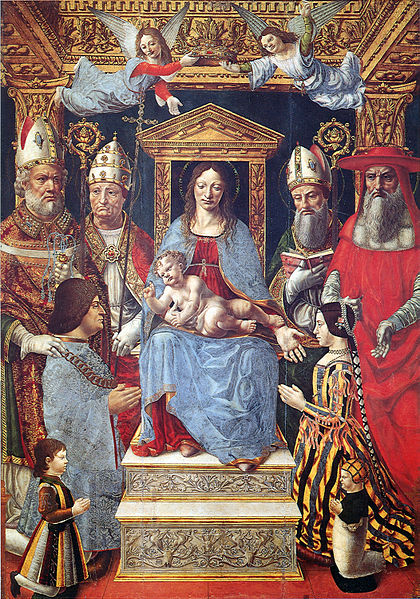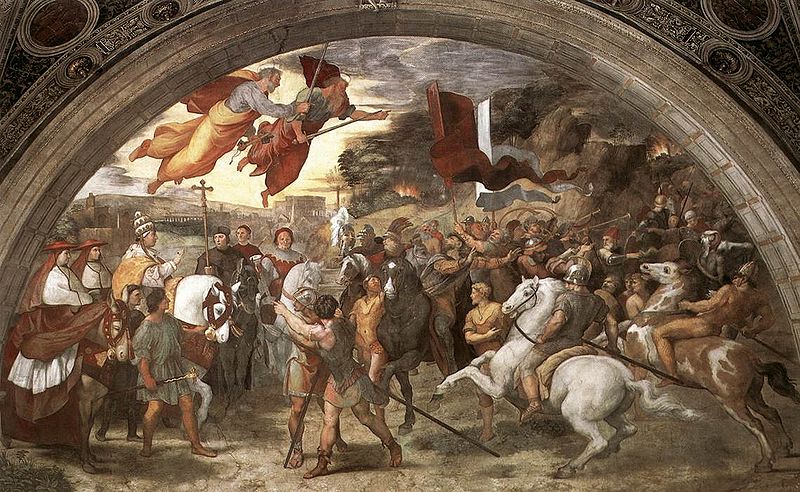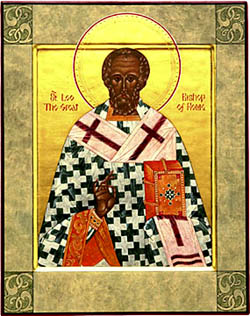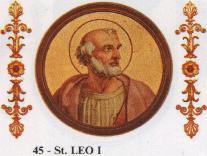<Back to Index>
- Pope Leo I, 391
PAGE SPONSOR
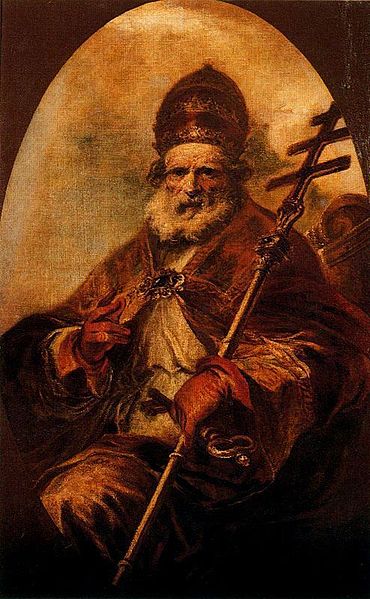
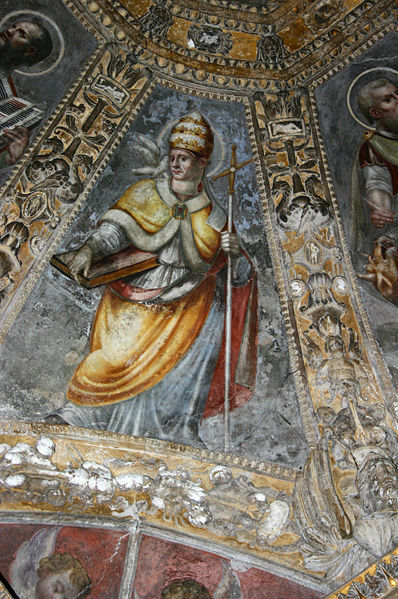
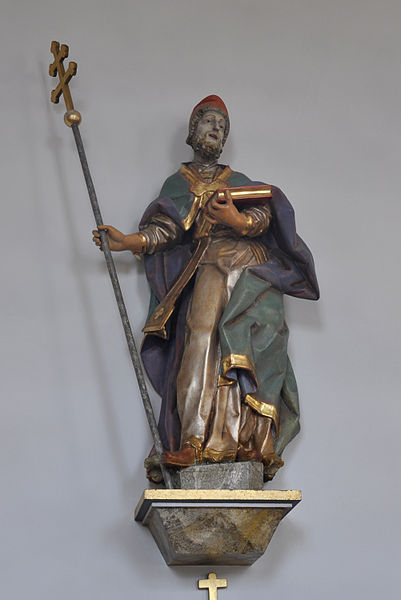
Pope Leo I (ca. 391 – November 10, 461) was pope from September 29, 440 to his death.
He was an Italian aristocrat, and is the first pope of the Catholic Church to have been called "the Great". He is perhaps best known for having met Attila the Hun in 452, persuading him to turn back from his invasion of Italy. He is also a Doctor of the Church.
According to the Liber Pontificalis, he was a native of Tuscany. By 431, as a deacon, he occupied a sufficiently important position for Cyril of Alexandria to apply to him in order that Rome's influence should be thrown against the claims of Juvenal of Jerusalem to patriarchal jurisdiction over Palestine — unless this letter is addressed rather to Pope Celestine I. About the same time John Cassian dedicated to him the treatise against Nestorius written at his request. But nothing shows more plainly the confidence felt in him than his being chosen by the emperor to settle the dispute between Aëtius and Albinus, the two highest officials in Gaul.
During his absence on this mission, Pope Sixtus III died (August 11, 440), and Leo was unanimously elected by the people to succeed him. On September 29 he entered upon a pontificate which was to be epoch making for the centralization of the government of the Roman Church.
Leo was a significant contributor to the centralization of spiritual authority within the Church and in reaffirming papal authority. While the bishop of Rome had always been viewed as the chief patriarch in the Western church, much of the pope's authority was delegated to local diocesan bishops. Not without serious opposition did he succeed in reasserting his authority in Gaul. Patroclus of Arles (d. 426) had received from Pope Zosimus the recognition of a subordinate primacy over the Gallican Church which was strongly asserted by his successor Hilary of Arles. An appeal from Chelidonius of Besançon gave Leo the opportunity to reassert the pope's authority over Hilary, who defended himself stoutly at Rome, refusing to recognize Leo's judicial status. Feeling that the universal jurisdiction of the papacy was threatened, Leo appealed to the civil power for support, and obtained from Valentinian III the famous decree of June 6, 445, which recognized the primacy of the bishop of Rome based on the merits of Peter, the dignity of the city, and the Nicene Creed (in their interpolated form); ordained that any opposition to his rulings, which were to have the force of ecclesiastical law, should be treated as treason; and provided for the forcible extradition by provincial governors of anyone who refused to answer a summons to Rome. Faced with this decree, Hilary submitted to the pope, although under his successor, Ravennius, Leo divided the metropolitan rights between Arles and Vienne (450).
In 445, Leo disputed with Pope Dioscorus, St. Cyril's successor as Pope of Alexandria, insisting that the ecclesiastical practice of his see should follow that of Rome on the basis that Mark the Evangelist, the disciple of Saint Peter and
founder of the Alexandrian Church, could have had no other tradition
than that of the prince of the apostles. This, of course, was not the
position of the Copts, who saw the ancient patriarchates as equals.
Regarding Africa, the fact that the African province of Mauretania Caesariensis had been preserved to the empire and thus to the Nicene faith during the Vandal invasion, and in its isolation was disposed to rest on outside support, gave Leo an opportunity to assert his authority there, which he did decisively in regard to a number of questions of discipline.
Regarding Italy, in a letter to the bishops of Campania, Picenum, and Tuscany (443) he required the observance of all his precepts and those of his predecessors; and he sharply rebuked the bishops of Sicily (447) for their deviation from the Roman custom as to the time of baptism, requiring them to send delegates to the Roman synod to learn the proper practice.
Regarding Greece, because of the earlier line of division between the western and eastern parts of the Roman Empire, Illyria was ecclesiastically subject to Rome. Pope Innocent I had constituted the metropolitan of Thessalonica his vicar, in order to oppose the growing influence of the patriarch of Constantinople in
the area. In a letter of about 446 to a successor bishop of
Thessalonica, Anastasius, Leo reproached him for the way he had treated
one of the metropolitan bishops subject to him; after giving various
instructions about the functions entrusted to Anastasius and stressing
that certain powers were reserved to the pope himself, Leo wrote: "The
care of the universal Church should converge towards Peter's one seat,
and nothing anywhere should be separated from its Head."
A favorable occasion for extending the authority of Rome in the East was offered in the renewal of the Christological controversy by Eutyches, who in the beginning of the conflict appealed to Leo and took refuge with him on his condemnation by Flavian. But on receiving full information from Flavian, Leo took his side decisively. In 451 at the Council of Chalcedon, after Leo's Tome on
the two natures of Christ was read out, the bishops participating in
the Council cried out: "This is the faith of the fathers ... Peter has spoken thus through Leo ..."
An uncompromising foe of heresy, Leo found that in the diocese of Aquileia, Pelagians were received into church communion without formal repudiation of their errors; he wrote to rebuke them, making accusations of culpable negligence, and required a solemn abjuration before a synod.
Manicheans fleeing before the Vandals had come to Rome in 439 and secretly organized there; Leo learned of this around 443, and proceeded against them by holding a public debate with their representatives, burning their books, and warning the Roman Christians against them.
Nor was his attitude less decided against the Priscillianists. Bishop Turrubius of Astorga, astonished at the spread of this sect in Spain,
had addressed the other Spanish bishops on the subject, sending a copy
of his letter to Leo, who took the opportunity to exercise Roman policy
in Spain. He wrote an extended treatise (July 21, 447), against the
sect, examining its false teaching in detail, and calling for a Spanish
general council to investigate whether it had any adherents in the
episcopate, but this was prevented by the political circumstances of
Spain.
At the Second Council of Ephesus in 449 AD, Leo's representatives delivered his famous Tome (Latin text, a letter), or statement of the faith of the Roman Church in the form of a letter addressed to Archbishop Flavian of Constantinople, which repeats, in close adherence to Augustine, the formulas of western Christology, without really touching the problem that was agitating the East. The council did not read the letter, and paid no attention to the protests of Leo's legates, but deposed Flavian and Eusebius of Dorylaeum, who appealed to Rome.
It was presented again at the subsequent Council of Chalcedon as
offering a solution to the Christological controversies still raging
between East and West. This time it was read out. The acts of the
council report: "After the reading of the foregoing epistle, the most
reverend bishops cried out: This is the faith of the fathers, this is
the faith of the Apostles. So we all believe, thus the orthodox believe.
Anathema to him who does not thus believe. Peter has spoken thus
through Leo. So taught the Apostles. Piously and truly did Leo teach, so
taught Cyril. Everlasting be the memory of Cyril. Leo and Cyril taught
the same thing, anathema to him who does not so believe. This is the
true faith. Those of us who are orthodox thus believe. This is the faith
of the fathers. Why were not these things read at Ephesus? These are
the things Dioscorus hid away."
Leo demanded of the emperor that an ecumenical council should be held in Italy, and in the meantime, at a Roman synod in October 449, repudiated all the decisions of the "Robber Synod". Without going into a critical examination of its dogmatic decrees, in his letters to the emperor and others he demanded the deposition of Eutyches as a Manichean and Docetic heretic.
With the death of Theodosius II in 450 and the sudden change in the Eastern situation, Anatolius, the new patriarch of Constantinople fulfilled Leo's requirements, and his Tome was everywhere read and recognized.
Leo was now no longer desirous of having a council, especially since it was not to be held in Italy. Instead, it was called to meet at Nicaea, then subsequently transferred to Chalcedon, where his legates held at least an honorary presidency, and where the bishops recognized him as the interpreter of the voice of Peter and as the head of their body, requesting of him the confirmation of their decrees.
He firmly declined to confirm their disciplinary arrangements, which seemed to allow Constantinople a practically equal authority with Rome and regarded the civil importance of a city as a determining factor in its ecclesiastical position; but he strongly supported its dogmatic decrees, especially when, after the accession of Leo I the Thracian (457), there seemed to be a disposition toward compromise with the Eutychians.
He succeeded in having an imperial patriarch, and not the Oriental Orthodox Pope Timotheus Aelurus, chosen as Coptic Orthodox Pope of Alexandria on the murder of Greek Patriarch Proterius of Alexandria.
The
approaching collapse of the Western Empire gave Leo a further
opportunity to appear as the representative of lawful authority.
In 452, Attila invaded Italy, sacking cities such as Aquileia and heading for Rome. He allegedly demanded that the sister of the reigning Emperor Valentinian III be sent to him with a dowry. In response, the Emperor sent three envoys to negotiate with Attila: Gennadius Avienus, who had been a consul in 450, Trygetius, who was a former praefectus praetorio, and Leo. We do not know much about the negotiations, but Attila withdrew. This outcome has been debated among historians for centuries. A large sum of gold that the pope possibly carried with him or Attila´s logistical and strategic concerns may have been the true reasons for Attila's mercy. His army was probably laden with booty from plunder; a plague broke out in northern Italy; food shortages may also be responsible for Attila´s withdrawal, as well as military actions of the Eastern Emperor Marcianus on the Danube frontier. Furthermore, we know next to nothing of the whereabouts of Aëtius at that time; perhaps Attila or his warriors felt endangered by their arch-enemy from the Catalaunian plains. The pope's plea for mercy may well have merely served as an honorable excuse for not continuing on and sacking the Roman capital. John B. Bury remarked:
"The fact of the embassy cannot be doubted. The distinguished ambassadors visited the Hun's camp near the south shore of Lake Garda. It is also certain that Attila suddenly retreated. But we are at a loss to know what considerations were offered him to induce him to depart. It is unreasonable to suppose that this heathen king would have cared for the thunders or persuasions of the Church. The Emperor refused to surrender Honoria, and it is not recorded that money was paid. A trustworthy chronicle hands down another account which does not conflict with the fact that an embassy was sent, but evidently furnishes the true reasons which moved Attila to receive it favourably. Plague broke out in the barbarian host and their food ran short, and at the same time troops arrived from the east, sent by Marcian to the aid of Italy. If his host was suffering from pestilence, and if troops arrived from the east, we can understand that Attila was forced to withdraw. But whatever terms were arranged, he did not pretend that they meant a permanent peace. The question of Honoria was left unsettled, and he threatened that he would come again and do worse things in Italy unless she were given up with the due portion of the Imperial possessions."
However, Christian historians celebrated Leo's actions, giving him all the credit for this successful embassy. According to Prosper of Aquitaine, Attila was so impressed by Leo that he withdrew. Jordanes says that Attila was afraid of sharing the fate of the Visigothic king Alaric, who died shortly after sacking Rome in 410. Paul
the Deacon, in the late 8th century, relates that an enormously huge
man dressed in priestly robes and armed with a naked sword, visible only
to Attila, threatened him and his army with death during his discourse
with Leo, and this prompted Attila to submit to his request. Unfortunately Leo's intercession could not prevent the sack of the city by the Vandals in 455, but murder and arson were repressed by his influence. He died probably on November 10, 461.
In his Nativitate Domini, in the Christmas Day sermon "Christian, Remember your Dignity" Leo appears to articulate a fundamental and inclusive human dignity and equality: The saint, the sinner, and the unbeliever are all equal as sinners, and none is excluded in the call to "happiness":
Our Saviour, dearly - beloved, was born today: let us be glad. For there is no proper place for sadness, when we keep the birthday of the Life, which destroys the fear of mortality and brings to us the joy of promised eternity. No one is kept from sharing in this happiness. There is for all one common measure of joy, because as our Lord the destroyer of sin and death finds none free from charge, so is He come to free us all. Let the saint exult in that he draws near to victory. Let the sinner be glad in that he is invited to pardon. Let the gentile take courage in that he is called to life.
The significance of Leo's pontificate lies in his assertion of the universal jurisdiction of the Roman bishop, as expressed in his letters, and still more in his ninety - six extant orations. This assertion is commonly referred to as the doctrine of Petrine supremacy.
According to Leo and several Church Fathers, as well as certain interpretations of the Scriptures, the Church is built upon Peter, in pursuance of the promise of Matthew 16:16-19. Peter participates in everything which is Christ's; what the other apostles have in common with him they have through him. What is true of Peter is true also of his successors. Every other bishop is charged with the care of his particular flock, the Roman pontiff with that of the whole Church. Other bishops are his assistants in this great task. In Leo's eyes the decrees of the Council of Chalcedon acquired their validity from his confirmation.
Leo's letters and sermons reflect the many aspects of his career and personality, including his great personal influence for good, and are invaluable historical sources. His rhythmic prose style, called cursus leonicus, influenced ecclesiastical language for centuries.
The Roman Catholic Church and many Anglican churches mark November 10 as the feast day of Saint Leo, given in the Martyrologium Hieronymianum and the 8th century Calendar of Saint Willibrord as the date of his death and entry to heaven. His feast was once celebrated in Rome on June 28, the anniversary of the placing of his relics in Saint Peter's Basilica, but in the 12th century the Gallican Rite feast of April 11 was admitted to the General Roman Calendar, which maintained that date until 1969. Some traditionalist Catholics continue to observe pre 1970 versions of that calendar.
The Eastern Orthodox Church celebrates Saint Leo on February 18.
Leo
was originally buried in his own monument. However, some years after
his death, his remains were put into a tomb that contained the first
four Pope Leos. In the 18th century Leo the Great's relics were
separated from those of the other Leo's and he was given his own chapel.
Troparion (Tone 3)
- You were the Church's instrument
- in strengthening the teaching of true doctrine;
- you shone forth from the West like a sun dispelling the errors of the heretics.
- Righteous Leo, entreat Christ God to grant us His great mercy.
Troparion (Tone 8)
- O Champion of Orthodoxy, and teacher of holiness,
- The enlightenment of the universe and the inspired glory of true believers.
- O most wise Father Leo, your teachings are as music of the Holy Spirit for us!
- Pray that Christ our God may save our souls!
Kontakion (Tone 3)
- Seated upon the throne of the priesthood, glorious Leo,
- you shut the mouths of the spiritual lions.
- With divinely inspired teachings of the honored Trinity,
- you shed the light of the knowledge of God up-on your flock.
- Therefore, you are glorified as a divine initiate of the grace of God.
